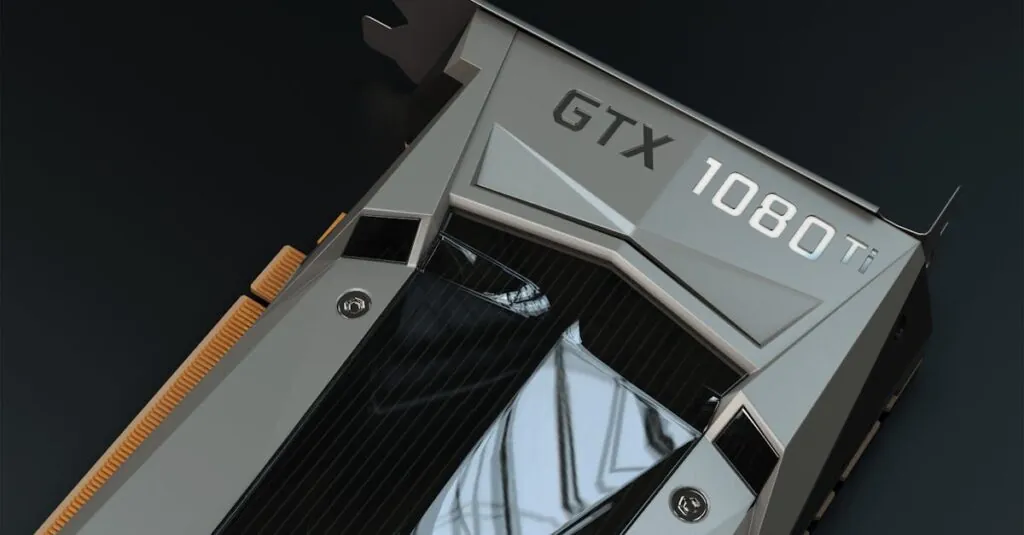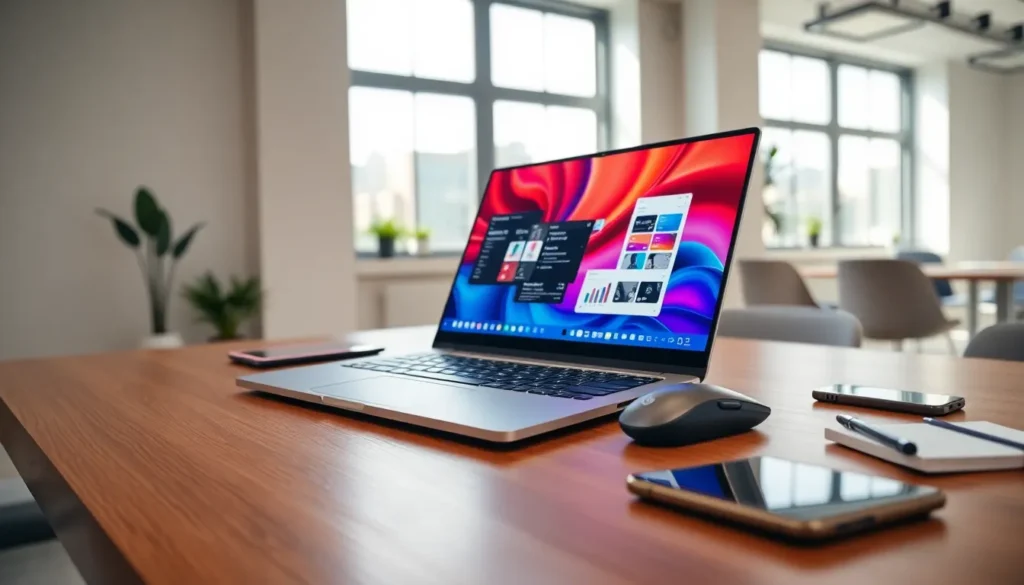Table of Contents
ToggleIn a world where gaming and graphic design demand more power than ever, the external GPU (eGPU) is the superhero your laptop never knew it needed. Imagine unleashing the graphics potential of your portable device without the bulk of a desktop. It’s like giving your computer a shot of espresso—suddenly, everything’s faster, smoother, and way more fun.
What Is an External GPU?
An external GPU, often referred to as an eGPU, is a dedicated graphics card housed outside the main computer unit. This technology connects to a laptop or a compact device via Thunderbolt 3 or USB-C ports. Designed to improve graphics performance, an eGPU enables users to boost their system’s visual capabilities significantly.
Many professionals and gamers utilize external GPUs to access advanced graphics without relying on the internal components of their laptops. Increased frame rates during gaming and enhanced rendering speeds in graphic design applications emerge from this setup. A multitude of external GPU models exists on the market, including options from brands like Razer, ASUS, and Gigabyte.
Users often leverage eGPUs to tackle demanding tasks such as 3D modeling or video editing. When attached, an external GPU can provide desktop-class graphics performance, making it suitable for high-resolution displays and multiple monitor setups. These devices often feature dedicated cooling systems to ensure optimal performance levels are maintained during use.
Additionally, eGPUs offer flexibility for users who prefer portability. By allowing easy connection and disconnection, an external GPU can adapt to various environments, from home offices to coffee shops. This versatility serves as a key factor in their growing popularity among content creators and gamers alike.
Ultimately, an external GPU represents a practical solution for those needing enhanced graphics capabilities without sacrificing portability. As technology continues to evolve, the application of eGPUs is likely to expand, reflecting their importance in modern computing.
Benefits of Using an External GPU
External GPUs provide significant advantages for users seeking enhanced visual capabilities. Many individuals leverage these devices for various applications, from gaming to professional design.
Enhanced Graphics Performance
Enhanced graphics performance becomes evident with the use of an external GPU. Professionals relying on resource-intensive software see improved rendering speeds and graphics quality. Increased memory bandwidth allows for smoother multitasking and better support for high-resolution displays. Users engaged in 3D modeling experience faster object manipulation and construction. Those editing videos benefit from quicker exports and real-time playback, making workflows more efficient.
Improved Gaming Experience
Gaming experiences greatly improve through the integration of external GPUs. Gamers gain access to increased frame rates, leading to smoother gameplay and reduced lag. Higher graphical settings become more achievable, creating immersive environments with detailed textures and effects. Many users also enjoy the flexibility of upgrading their graphics capabilities without replacing the entire system. Multiple monitor setups enhance the overall gaming experience, providing expansive views and improved performance. Gamers seeking competitive edges find that eGPUs significantly enhance their gameplay.
Choosing the Right External GPU
Selecting an appropriate external GPU involves various factors that ensure compatibility and optimal performance. The decision-making process can significantly impact both graphics performance and overall system efficiency.
Compatibility Considerations
Compatibility ranks as a primary concern when choosing an external GPU. Users must verify that their laptops support Thunderbolt 3 or USB-C connections, as incompatible ports can hinder performance. It’s crucial to check whether the eGPU works seamlessly with the operating system, whether macOS or Windows. Additionally, considering the laptop’s internal GPU capabilities helps ensure that the eGPU enhances, rather than saturates, the existing hardware. Checking laptop specifications against the eGPU requirements provides a clear understanding of performance expectations, making compatibility checks essential before any purchase.
Key Features to Look For
Key features significantly influence the effectiveness of an external GPU. First, users should assess the GPU’s processing power and memory, as these directly affect graphics performance. A model with at least 8GB of VRAM is ideal for demanding tasks. Second, the eGPU’s cooling system is crucial, as efficient cooling prevents overheating during intense workloads. Furthermore, look for multiple output options that allow connectivity with various displays. Lastly, consider the build quality and design, as durable materials contribute to longevity and optimal performance. Evaluating these features ensures users select an eGPU capable of meeting their specific needs and expectations.
Setup and Installation Process
Setting up an external GPU (eGPU) involves a straightforward process. First, ensure compatibility with the laptop, confirming it supports Thunderbolt 3 or USB-C connections. Next, gather all necessary components including the eGPU enclosure, power supply, and graphic card.
Connecting the eGPU starts with installing the graphics card into the eGPU enclosure. Manufacturers provide instructions for proper installation. After securing the card, connect the enclosure to the laptop using a suitable Thunderbolt 3 or USB-C cable.
Powering on the eGPU follows the connection. Upon powering it up, the laptop typically recognizes the eGPU automatically. It is essential to install the latest drivers for optimal performance. Drivers are available from the GPU manufacturer’s website.
Once installed, a quick system reboot may enhance performance. Opening graphics-intensive applications immediately demonstrates the eGPU’s capabilities. Users should notice significant boosts in frame rates and rendering speeds during usage.
Testing several applications also verifies the eGPU’s functionality. Running benchmarks helps assess whether the performance aligns with expectations. When any issues arise, consulting the user manual provides troubleshooting insights.
Finally, cable management plays a crucial role in maintaining a tidy workspace. Keeping cables organized prevents wear and promotes connectivity stability. An efficiently set up eGPU not only boosts performance but also enhances the overall computing experience.
Top External GPUs on the Market
Several external GPUs (eGPUs) currently stand out for their performance and features. The Razer Core X ranks highly due to its versatile compatibility and powerful graphics capabilities. It supports numerous GPUs, including NVIDIA and AMD models.
The Akitio Node offers an optimal solution for creatives seeking a balance between performance and affordability. Users appreciate its compact design and user-friendly installation process. It works seamlessly with various Thunderbolt 3 laptops.
Another popular choice is the Gigabyte AORUS Gaming Box, which integrates a graphics card with the eGPU enclosure. This device delivers impressive performance in gaming scenarios while maintaining portability. Gamers favor its ready-to-use nature, eliminating compatibility concerns.
Also notable is the ASUS XG Station Pro, recognized for its sleek design and cooling system. Many users commend its build quality and the inclusion of extra ports for peripherals. This feature provides added convenience for users requiring additional connectivity options.
The Mantiz Venus stands out for its robust expansion capabilities, including support for additional storage. A unique feature includes a built-in USB hub, offering efficient connectivity for various devices. Professionals appreciate this feature while those in creative fields benefit from the added storage space.
Lastly, the Sonnet eGFX Breakaway Box is perfect for high-performance use cases. Its large power supply accommodates power-hungry graphics cards, appealing to serious gamers and professionals alike. Flexibility in graphics card options makes this eGPU a preferred choice.
These external GPUs enhance the performance of laptops significantly, catering to gamers and graphic design professionals alike. Each option provides distinct advantages to meet diverse user needs while improving overall graphics performance.
Conclusion
External GPUs are revolutionizing the way users approach graphics performance on laptops. By providing a significant boost in speed and rendering capabilities they empower gamers and professionals alike to tackle demanding tasks with ease. The flexibility of upgrading graphics without overhauling an entire system is a game changer for many.
Selecting the right eGPU involves careful consideration of compatibility and features ensuring that users get the most out of their investment. With a range of options available on the market each tailored to different needs there’s an eGPU suited for everyone.
Ultimately the integration of an external GPU can transform a laptop into a powerhouse capable of handling the latest games and intensive graphic applications. This technology is paving the way for a more versatile and efficient computing experience.




